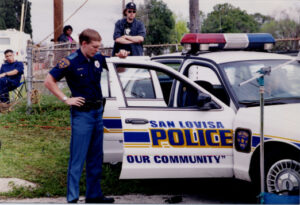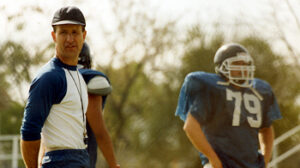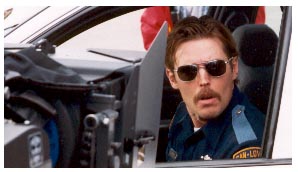
INT – PATROL CAR – High School Practice Field — DAY
Scene #24
EXT – PATROL CAR – High School Practice Field — DAY
Scene #25
INT – PATROL CAR – High School Practice Field — DAY
Scene #26
EXT – HIGHWAY — DAY
Scene #104

The Coach and his boys
Today looked like an easy day on paper — three scenes, all continuous, in a parked patrol car and one scene by the side of the highway, again with no moving vehicles. There were elements, however, that made it a difficult (but theoretically makable) day. Some were anticipated (15 set-ups altogether) and some were not.
We started out with coverage on the coach and the high school football players we had enlisted for scene 24. It was a lot of work, especially since I was working with a relatively inexperienced 1st AD. This meant that I had to do all of the arranging of football players for their background action and their group moment talking to Francis. I know nothing about football (a crime in Texas), but managed to set them up with some realistic action with the help of the real coach, who blew his whistle and barked orders.
Joe Miller, who plays the coach in the film, showed up on set with the most wretched tight tan spandex shorts on. I told Yvonne (costume designer) that I was picturing sweat pants or something like that. She allowed as how she had none. I suppose the script did say “tight lycra coaching outfit,” but jeez, poor Joe looked like he was ready to play the coach in some kind of creepy gay porn flick. As I was on the verge of panic, Joe said that he had some blue windbreaker pants of his own. Crisis averted.

The aborted U-turn
Then, one of the key vehicles that was scripted didn’t show up. The scene calls for some boys to skip practice and drive away in a Jeep. Morning calls to them over the PA in the patrol car to scold them for attempting a U-turn, which leads to him talking to the boys on the field. The scene eventually ends in a nice awkward moment with the coach. No one could adequately explain why the Jeep wasn’t there, so I enlisted the 2nd AD’s pick-up truck, which was better anyway. Second crisis averted.

Bill Sage getting ready for a two-shot
The meat of scenes 23 – 25 is Morning talking wistfully about his days on the high school football team. It’s a nice opportunity for some exposition on Morning’s character and Francis’ (and our) first chance to see the vulnerability behind his facade of cowboy cop. We covered the scenes with eight separate set-ups, which took a considerable amount of time. Tim and I discussed 3 PM as being the optimum time to be on the move to our next location. This is where we would film scene 104, Francis pulling the coach over for speeding six months or so after Morning has been killed. But, by the time we were done with 24 – 26, it was 4:30 PM. Not good.
Any company move, whether it’s 2 blocks or 10 miles, is a big deal. By definition, all the equipment needs to be loaded onto the trucks, the hatches have to be battened down in the motor homes and the entire crew has to wend its way to the next location, repark all the vehicles and unload all the necessary equipment. No matter how near or far, it’s always at least an hour by the time the crew is ready for action again. The net result is an hour’s less sun.
The location for sc. 104 was a service road off highway 281, chosen for it’s proximity to the highway and because the San Antonio skyline provided a nice backdrop. Tim and I arrived first and discussed strategy for shooting the scene as efficiently as possible. We agreed that we could only afford one or at most two takes of the transitional stuff — Francis walking to and from the coach’s pick-up truck, etc. That was our only chance of getting the important shots: Francis’ first (and unexpected) release of emotion after the death of his partner, Morning, and the coach’s reaction.
Once the crew and equipment arrived, we powered through several shots of the vehicles and Francis’ walk from his patrol car to the truck. Then, we shot Joe’s coverage. He was excellent, providing a great foil for Francis’ surprise emotional moment. When it came time for Billy D’s coverage, however, we were really fighting the light.

Francis doesn’t write the Coach a ticket
Now, normally, one doesn’t shoot the lead actor’s coverage last. They work the hardest, and it’s most important that their coverage be good. After all it’s the leads that carry the film. If they’re tired or unhappy, it hurts the film more than if a day player is inconvenienced by sitting around all day doing off-camera work or just plain waiting (of which there is always a considerable amount). In this case, however, Joe came from Dallas for this, his one day of work on the film. We hadn’t budgeted for an additional day’s work or travel for him. If worse came to worst, we could pick up Bill’s coverage on another day at no additional cost to the production but for a tighter schedule. And, of course, worse did come to worst.
When we were finally set up for Bill’s coverage, there was just a sliver of direct sunlight left in the sky. After the first take, we had to reset a few feet away to chase the sun. This was repeated for every subsequent take. The most annoying thing about this was that the changing background meant that I would have to use moments from one entire take, as opposed to using pieces from several; if the background changes without the actor moving in a motivated fashion it becomes a continuity error that distracts from the content of the scene. A secondary problem was that we had to move closer to the highway to chase the light and the rush hour traffic on 281 was growing steadily louder.
A third problem, not to be dismissed lightly, was that Bill was finding it difficult to concentrate with the constant moves and readjustments. Film actors, under the best of circumstances, must work with innumerable distractions on the set, such as the camera, lights and crew surrounding them at all times. But, an experienced crew will avoid eye contact during a take and a courteous director will make every effort to provide an atmosphere conducive to good acting. Jumping around a highway median with the roar of traffic and failing light doesn’t exactly accomplish the latter.
We finished Bill’s coverage and wrapped, but I was not pleased with the problems we encountered with the last set-up and it was clear to me that Billy D. was not happy either. Alan Green, the sound mixer, confirmed that the sound was lousy and Tim felt that the light had dropped to the point that the picture quality was probably not up to his standards. By the time I gathered this information, Bill had left the set. I didn’t want his weekend to be ruined, though, so I called him to let him know that we would commit to reshooting his coverage the following week when an opportunity arose.
All things considered, the day went excellently well. Another several steps forward and a tiny step back. Not a terrible way to end week one.

Ron reflects on the lack of light
– Joseph Pierson



